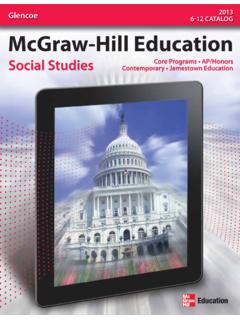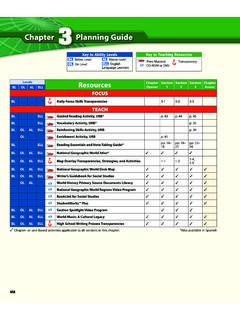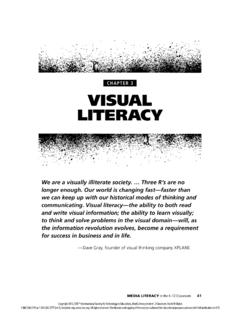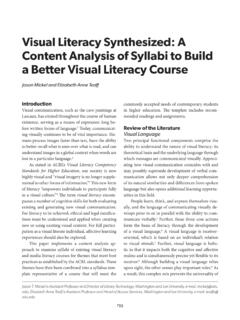Transcription of The Information Literacy User’s Guide
1 The Information Literacy user s GuideEdited by Greg Bobish and Trudi JacobsonDeborah Bernnard, Greg Bobish, Jenna Hecker, Irina Holden, Allison Hosier, Trudi Jacobson, Tor Loney, and Daryl Bullis The Information Literacy user s Guide : An Open, Online Textbook Deborah Bernnard, Greg Bobish, Jenna Hecker, Irina Holden, Allison Hosier, Trudi Jacobson, Tor Loney, and Daryl Bullis Edited by Greg Bobish and Trudi Jacobson 2014 Deborah Bernnard, Greg Bobish, Jenna Hecker, Irina Holden, Allison Hosier, Trudi Jacobson, Tor Loney, and Daryl Bullis ISBN: 978-0-9897226-2-9 This work is licensed under a Creative Commons Attribution-NonCommercial-ShareAlike Unported by Open SUNY Textbooks, Milne Library (IITG PI)State University of New York at Geneseo, Geneseo, NY 14454 Cover design by William JonesAbout this TextbookGood researchers have a host of tools at their disposal that make navigating today s com-plex Information ecosystem much more manageable.
2 Gaining the knowledge, abilities, and self-reflection necessary to be a good researcher helps not only in academic settings, but is invaluable in any career, and throughout one s life. The Information Literacy user s Guide will start you on this route to Information Literacy user s Guide is based on two current models in Information Literacy : The 2011 version of The Seven Pillars Model, developed by the Society of College, National and University Libraries in the United Kingdom1 and the conception of Information lit-eracy as a metaliteracy, a model developed by one of this book s authors in conjunction with Thomas Mackey, Dean of the Center for Distance Learning at SUNY Empire State These core foundations ensure that the material will be relevant to today s students.
3 The Information Literacy user s Guide introduces students to critical concepts of Information Literacy as defined for the Information -infused and technology-rich environment in which they find themselves. This book helps students examine their roles as Information creators and sharers and enables them to more effectively deploy related skills. This textbook includes relatable case studies and scenarios, many hands-on exercises, and interactive the AuthorsDeborah Bernnard is Head of the Dewey Graduate Library at the University at Albany, State University of New York. She is also a veteran Information Literacy instructor.
4 She was a member of the committee that created UNL 205, Information Literacy , a one-credit un-dergraduate course, taught by University at Albany librarians since 2000. She also teaches a graduate course; Information Literacy Instruction: Theory and Technique. She has au-thored several book chapters and articles on Information Literacy topics. Greg Bobish is an Associate Librarian at the University at Albany, State University of New York. He has taught credit-bearing Information Literacy courses since 2000 and enjoys experimenting with new educational technologies and new pedagogical approaches as he tries to convey the relevance of Information Literacy to his students lives.
5 He has received the Chancellor s and the President s awards for Excellence in Bullis is the Lead Instruction Librarian at Babson College. He recieved his BA in Classics and Russian from the University of New Hampshire, an MA in Russian and an MLS from the University at Albany, State University of New York. He has taught credit 1 in Information Literacy and is currently researching best practices for adapting TBL methods to bibliographic instruction Hecker is an instructional developer for the University at Albany, State University of New York and teaches Information Literacy in both face-to-face and online formats.
6 She received her MLIS from the University of Rhode Island. Irina Holden teaches Information Literacy in the Sciences and works as an Information Literacy and Science Outreach Librarian in the Science Library at the University at Albany, State University of New York. Her research interests include science Literacy , reference and instruction in both traditional and virtual environments, sustainability and first year experi-ence courses. Ms. Holden is a native of Hosier earned her MSIS from the University at Albany, State University of New York in 2011. She is currently an Information Literacy Librarian at Coastal Carolina University.
7 Trudi Jacobson is the Head of the Information Literacy Department at the University at Albany, State University of New York. She and Thomas Mackey developed the concept of metaliteracy, which has infused her teaching and her research. She loves the challenge and excitement of effective new teaching methods, and is currently involved in the development of a metaliteracy badging system. She was the recipient of the Miriam Dudley Instruction Librarian of the Year award in 2009. She is honored to have taught or mentored all but one of the co-authors of this book when they were graduate Loney is a Youth Services Librarian at Albany Public Library, concentrating on teen engagement with a focus on creative arts and emerging technologies.
8 He previously worked as an Information Literacy Librarian and Instructor at the University at Albany, State University of New York, where he earned his s NotesThe Information Literacy user s Guide : An Open, Online Textbook is written for teaching-librar-ians and faculty who conduct instruction either online or face-to-face. It is a contemporary take on what the Information literate learner should know in the 21st century. Using the 7 Pillars of Information Literacy as the framework, the textbook is a hands-on step by step Guide that can be incorporated in for-credit courses, embedded librarian projects and also one-shot instruction question many librarians and academics struggle with today is what does it mean to be Information literate in the 21st century?
9 Oftentimes we look at the technological innova-tions that has changed the very nature of Information as the catalyst for this disruption, but this textbook challenges us to think about the Information cycle from the base levels (what is a book, what is an article etc.) to the broader and deeper questions about Information , like what ownership means in in our participatory culture. It transcends the basic pretense that technology has changed the meaning of Information Literacy and delves deeper into looking at networks, both physical and virtual and the Information gathering and creation inside those book examines Information Literacy as it relates to the liberal arts, as well as the hard sciences, and is layered with excellent classroom examples that can be incorporated in classes with a research component.
10 The textbook is ideal for undergraduate level work and could be used as a companion piece to a discipline-focused class, like Anthropology or Chemistry, or could be used as the base text to an Information Literacy course. Mark McBride, Monroe Community CollegeMark McBride is the Director of Library Services at Monroe Community College. Mark received holds an AS from Erie Community College, BA in Media Study from the University at Buffalo and received his MLS from the University of Buffalo, as well. His background is in Information Literacy & metaliteracy instruction.













